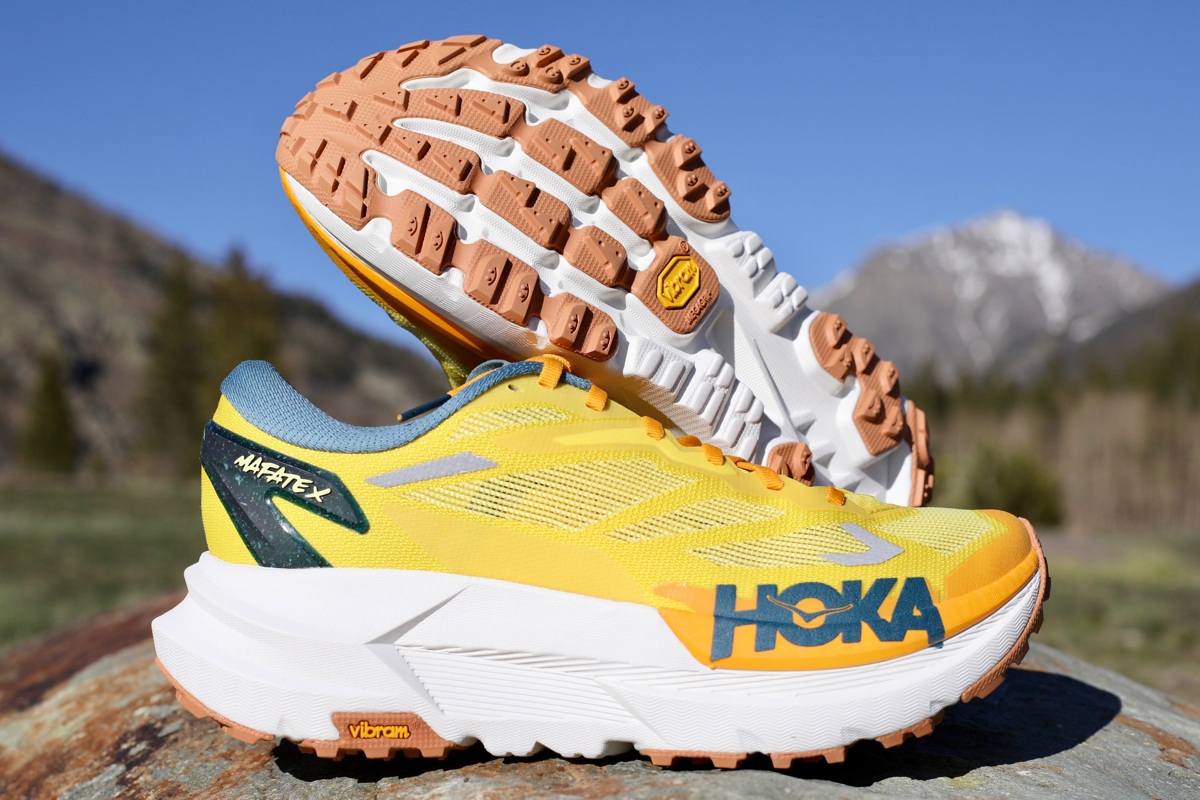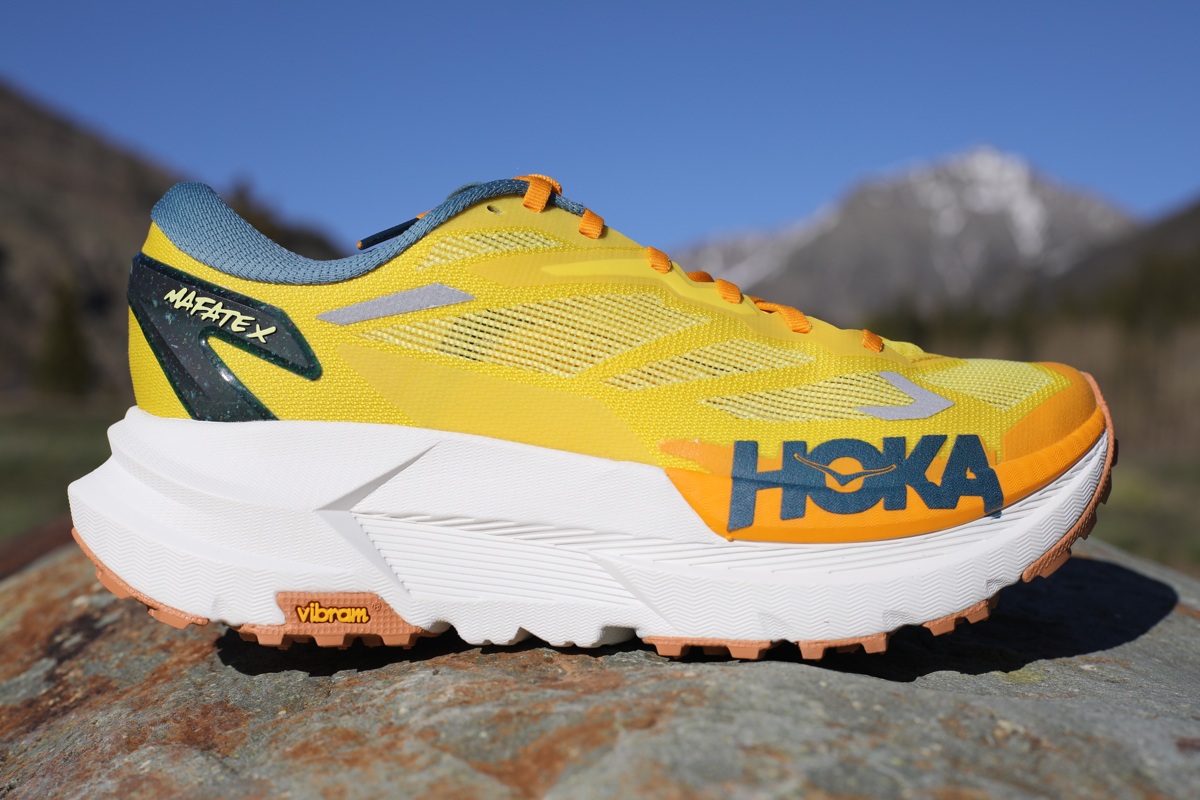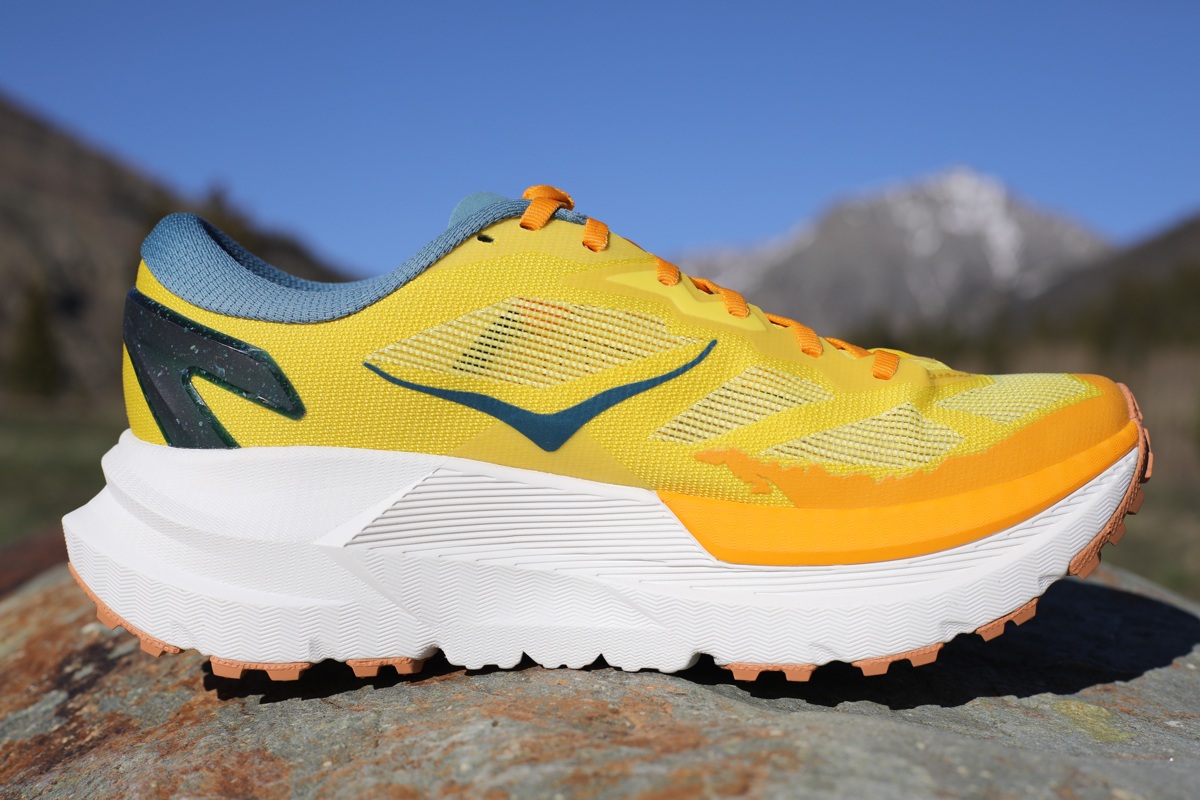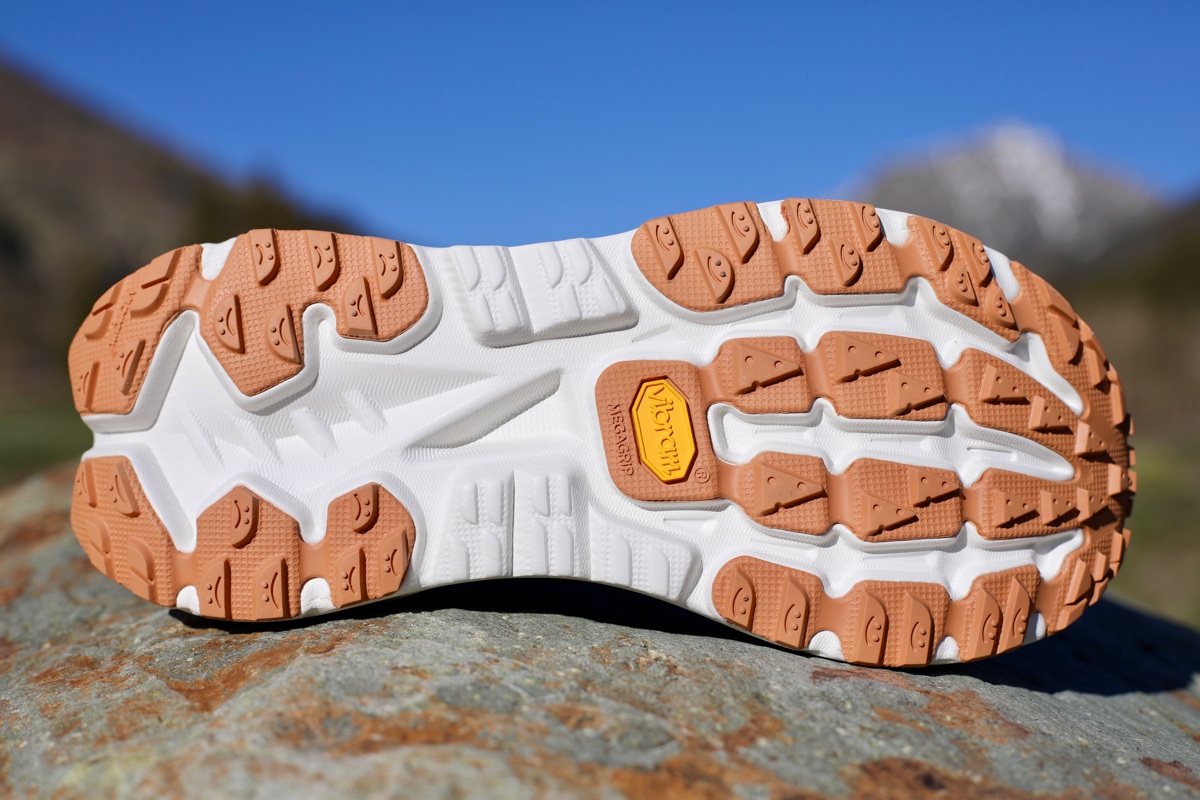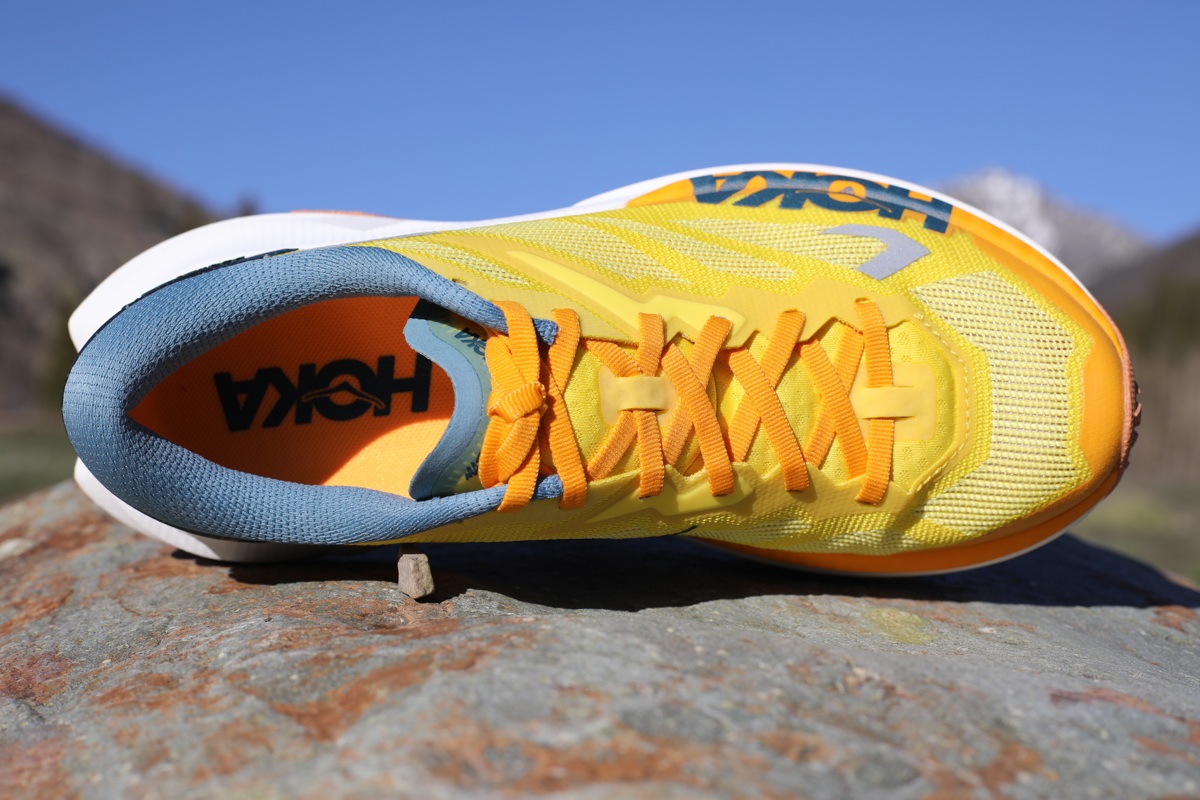The Hoka Mafate X ($225) fills a narrow gap in the brand’s trail running shoe lineup by having significantly more cushion than the Hoka Mafate Speed 4, and a broader platform than the Hoka Tecton X 3. This shoe is Hoka’s most cushioned model yet, with a whopping 49 millimeters of stack height under the heel and 41 millimeters at the toe for an 8-millimeter drop. Yet, its breathable woven upper, midsole with a carbon plate, and Vibram Megagrip outsole keep the shoe versatile enough for most trails, extended tempo workouts, and even racing. With an actual weight of 11.7 ounces (331 grams) for a U.S. men’s 9, this isn’t the lightest trail running shoe on the market by a long shot, especially when it comes to racing. However, given its roughly two inches of cushion underfoot, it feels lighter than you might expect.
I took the Mafate X onto trails, gravel roads, and a little bit of pavement around Central Oregon as spring transitioned into summer. I also took the shoe into steeper and more technical terrain than it was designed for, wore it for easy miles, and used it for a few speed workouts. Hoka refers to the Mafate X as a “gravel grinder,” and I agree that roads and non-technical trails are this shoe’s sweet spot. Overall, it delivers a plush, enjoyable ride without feeling clunky. After 103 miles, it shows little wear and earned a solid spot in my running shoe rotation.
Shop the Women's Hoka Mafate XShop the Men's Hoka Mafate X
Hoka Mafate X Upper
The Hoka Mafate X upper is constructed with single-layer woven mesh, with a toe bumper and an external TPU cradle on the heel for added structure and durability. The upper is light, breathable, and quick drying, contributing to the shoe’s overall light-for-its-size feel. It’s also durable. After more than 100 miles, mostly on trails, the upper shows almost no wear — just dirt, really. Speaking of dirt, I expected the seemingly thin textile material to allow a lot of Central Oregon’s “moondust” into the shoe, resulting in extra dirty toes. However, my toes have not collected more dirt than they do in any other trail running shoes.
The upper material hugs my midfoot and allows a little room for my toes to splay at the front of the shoe. The gusseted tongue adds to the secure fit and has just enough padding to feel comfortable but not hot or bulky. There’s also a bit of padding around the back of the heel collar, adding a touch of comfort around the Achilles tendon. During testing, the upper and laces remained secure, even through higher cadences on technical and steep terrain.
Hoka Mafate X Midsole
If you can imagine it, the Hoka Mafate X feels a bit like strapping inflatable rafts to your feet, and I don’t mean this in a negative way. I would also compare the feeling to riding a fat tire bike designed to float on snow or sand. The broad platform underfoot keeps the shoe from feeling too tippy, even with all that stack height and cushion. Additionally, the shoe profile incorporates a moderate amount of Hoka’s MetaRocker, the front-to-back curvature that Hoka is known for, which helps propel the foot forward. Too much rocker compromises stability, while too little feels flat and clunky. This shoe feels stable yet easy to run in, especially considering its 49-millimeter foam platform.
The Mafate X midsole incorporates a forked carbon plate sandwiched between two types of foam. On top is Hoka’s PEBA foam, also found in the Tecton X, which is designed for comfort and responsiveness. Indeed, it feels like the right balance of plush and firm. Below that is an H-shaped carbon fiber plate, which contributes to the shoe’s structure and support and increases its responsiveness and energy return. The bottom layer is a supercritical EVA foam, which is both lightweight and resilient.
While I stand by my comparison of the Mafate X to an inflatable watercraft I might take into whitewater, I was pleased with how this shoe performed during testing. It excels on easy to moderately paced runs of any distance on dirt or gravel roads and non-technical trails, though it’s a lot of shoe for workouts. And of course, all that cushion compromises ground feel. This shoe felt a little clunky during short speed intervals, and it’s not the most nimble option for scrambling up rocky faces. It would not be my top choice for fast intervals or short races. However, for the typical surfaces that most runners encounter during daily miles, its plush feel keeps your legs feeling fresh.
Hoka Mafate X Outsole
Like many trail running shoes from the brand, the Hoka Mafate X outsole features Vibram Megagrip, which has proven to perform well on a variety of trail conditions. It’s a durable, lightweight material common among top trail running shoes. It has 3.5-millimeter lugs, which are appropriate for the shoe’s intended use on gravel and dirt roads.
In testing, the shoe gripped well on a variety of terrain, from pavement to gravel forest roads, dirt doubletrack, and even steep singletrack. Since I live in a dry, high desert environment, I have not had much opportunity to test this shoe in mud yet. However, I never experienced insecure footing in loose dirt or rocks, nor does the outsole feel overly sticky on firm trails or pavement.
Hoka Mafate X Overall Impressions
Overall, the Hoka Mafate X is ideal for long miles on non-technical trails, doubletrack or gravel roads, or daily easy runs on mixed surfaces. It is a well-built shoe with standout features like a carbon plate layered between two types of high-quality foam, a durable woven upper, and Vibram Megagrip outsole. It feels comfortable, stable, and secure on just about any surface.
At the same time, it’s a lot of shoe. All of that cushion compromises ground feel and nimbleness, and its performance is limited on steep, rocky trails, as well as high-intensity speed workouts. It’s also relatively expensive compared to other trail running shoes, and it seems that shoes designed for long miles on dirt roads are in a fairly niche category.
Comparing the Mafate X to other shoes in Hoka’s line, it seems to live somewhere between the Hoka Challenger 8, which is a great road-to-trail shoe, and the Mafate Speed 4 or Tecton X 3, which are lightweight, responsive, and better suited to technical terrain and relatively shorter distances. Personally, I still prefer the Hoka Speedgoat 6 over the Mafate X for ultra distances and 100-mile races, but this shoe would be a good option for late in a race, when comforting achy feet takes precedence. I would also recommend this shoe to runners taking on the 200-mile distance.
Shop the Women's Hoka Mafate XShop the Men's Hoka Mafate X
Call for Comments
- Have you tried the Hoka Mafate X? What do you think?
- Do you have a favorite Hoka trail running shoe?
Our Favorite Trail Running Shoes
Check out our Best Trail Running Shoes article to learn about our current favorites!
